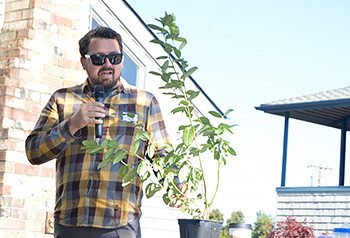Researcher Recommends Monitoring Fruit for SWD
Monitoring fruit for spotted wing drosophila, rather than trapping for it, should be a grower’s first-line of defense against the pest, according to a speaker at the OSU Blueberry Field Day, July 23 in Aurora.
 |
Jason Myers at the OSU Blueberry Field Day said growers should consider monitoring fruitfor spotted wing drosophila rather than trapping for it. |
“If you are monitoring the fruit, and you’re doing it regularly, you are going to find if there’s any larva in there, and you will find out pretty quickly that if you’re spraying on a weekly basis, you may be overtreating,” said Jason Myer of Northwest Berry Foundation.
In general, SWD is not a big fan of blueberries, Myer said. “The skin is a little too thick,” he said. Still, the tiny fruit fly has become a significant pest of blueberries, in large part because many packers have a zero tolerance for the pest.
When sampling fruit, Myer said the best place to start is on field edges. SWD doesn’t overwinter in blueberry fields, so typically enters from field borders. “Ninety-nine percent of the time, SWD is moving from a border habitat into a field. So, if you’re sampling a plant in the middle of the field … you’re kind of wasting your time, because if you find them there, you probably have a lot bigger issue on the field borders,” he said.
“It is an arboreal species,” Myer added. “It likes a good shaded canopy to hang out in. An open field is way too exposed, and they die really quickly when exposed to wind and sun.”
“Ninety-nine percent of the time, SWD is moving from a border habitat into a field. So, if you’re sampling a plant in the middle of the field … you’re kind of wasting your time, because if you find them there, you probably have a lot bigger issue on the field borders.”
|
When looking at which fruit to sample in a bush, he advised to pull from inside a plant. Fruit on the ends of laterals are less likely to be attacked by SWD because it is more exposed to weather, he said.
“Grabbing fruit from the middle of that canopy is the ideal location to up your chances of finding any SWD,” he said.
The fruit sampling procedure Myer displayed at the field day involved creating a mixture of water and salt in a plastic zip-lock bag, placing fruit in the mixture, and spilling out the contents on a tray to look for larvae.
Generally, Myer said, if a grower or crop consultant is catching SWD, it will be at a low threshold, given that early-season insecticide treatments are doing a good job of minimizing SWD pressure.
“Most of the insecticide treatments that are going on early, whether that’s a malathion, a Mustang or an organic treatment like Entrust, are pretty effective at knocking down those early instar larvae, and it really just breaks the cycle at that point,” Myer said. “And then you can have a prolonged period of clean fruit.”
Even if the pest is in fruit at that early-season stage, insecticide treatments will often prove effective, he said.
“I think a lot of the original thinking was that once SWD is in the fruit, it’s protected,” he said. “It’s not. They have breathing tubes that extend out of the fruit, and if they get a whiff of that insecticide, they die and that population cycle stops.
“So, as long as you’re catching SWD at a really low level, you’re not going to have a large crop-quality issue,” he said.